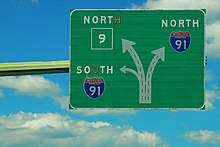Diagrammatic sign


A diagrammatic sign or diagrammatic guide sign is a type of guide sign that indicates destinations using a large, map-like illustration of the road layout. The term is most commonly associated with diagrammatic signs installed ahead of forks in controlled-access highways to indicate the destination of each lane.
Usage
[edit]
Diagrammatic signs are specified in the Manual on Uniform Traffic Control Devices developed by the United States Federal Highway Administration, as one of several options for exits and splits on multilane freeways. A simpler kind of diagrammatic sign without lane detail is allowed for indicating a series of exits along a conventional street or roundabout.[1] They also appear in other countries influenced by the MUTCD.
Diagrammatic signs have been a recommended method of signposting exits and splits in Massachusetts and New York. By contrast, California, Minnesota, Ohio, and Mississippi make extensive use of pull-through or arrow-per-lane signs to indicate lane assignments. Tennessee and Utah rely on pavement markings to communicate lane assignments.[2]
On December 14, 2020, the Federal Highway Administration proposed several changes to an upcoming edition of the MUTCD that would streamline some diagrammatic signs or eliminate the use of diagrammatic signs on freeways and expressways, citing the successful introduction of arrow-per-lane signs. Simplified diagrammatic signs would continue to be used at roundabouts and other conventional streets where lane detail is not required.[3]
Effectiveness
[edit]
Diagrammatic signs have been shown to be less effective than conventional, text-only signs (e.g., "Left 2 Lanes") and overhead arrow-per-lane signs because of the additional time it takes to comprehend them.[1] A 2006 study by the Texas A&M Transportation Institute found that diagrammatic signs performed poorly compared to text-only signs for left-side exits and performed similarly to text-only signs for right-side exits.[4] A 2008 study found a clear advantage to arrow-per-lane signs compared to diagrammatic signs, especially among older drivers.[5]
References
[edit]- ^ a b "Guide Signs—Freeways and Expressways". Manual on Uniform Traffic Control Devices (2009 ed.). Washington, D.C.: Federal Highway Administration. May 2012. Retrieved June 28, 2021.
- ^ Somers, Richard A.; Hawkins, H. Gene Jr.; Jasek, Debbie; Urbanik, Thomas II (September 1996). "An evaluation of guide signing at right multilane freeway exits with optional lanes" (PDF). College Station, Texas: Texas A&M Transportation Institute. pp. 29–37.
- ^ Federal Highway Administration (December 14, 2020). "National Standards for Traffic Control Devices; the Manual on Uniform Traffic Control Devices for Streets and Highways; Revision". Federal Register. Washington, D.C.: Office of the Federal Register. Retrieved June 29, 2021.
- ^ Chrysler, Susan T.; Williams, Alicia A.; Funkhouser, Dillon S.; Holick, Andrew J.; Brewer, Marcus A. (October 2006). "Driver comprehension of diagrammatic freeway guide signs" (PDF). College Station, Texas: Texas A&M Transportation Institute.
- ^ "Diagrammatic Freeway Guide Sign Design Final Report" (PDF). McLean, Virginia: Science Applications International Corporation. May 2008.
External links
[edit]Text is available under the CC BY-SA 4.0 license; additional terms may apply.
Images, videos and audio are available under their respective licenses.
